The Differences in Shape Stability for Hornbeam (Carpinus betulus L.) Lumber with and without Spiral Grain
Abstract
1. Introduction
2. Materials and Methods
2.1. Preparation of Hornbeam Lumber
2.2. Conditions of Air Drying
2.3. Types of Measurement on the Lumber
2.4. Measured Change of Shape by STN EN 1309-3 (49 1013)
2.5. Classification of Lumber According to Standards
2.6. Evaluation of Shape Stability by Statistical Methods
3. Results and Discussion
3.1. Changes of Spiral Grain
3.2. The Effect of Spiral Grain on Strength Properties
3.3. Warp Bow
3.4. Warp Crook
3.5. Visual Evaluation of Shape Changes
3.6. Classification of Lumber Strength
3.7. Statistical Evaluation—Warp Bow
3.8. Statistical Evaluation—Warp Crook
4. Conclusions
- Our research confirmed that the spiral grains remarkably affect shape stability. A warped bow with spiral grain values increased by almost 50% compared with lumber without spiral grain. This statement was confirmed even with statistical results where the set limit value of p < 0.05 was not exceeded, either with warp crook (p = 0.0436) or with warp bow (p = 0.00001).
- Regarding warp crook, statistical significance was also confirmed for different types of lumber (radial or tangential), where the significance value reached p = 0.0120. This result can be explained mainly by the original position of tangential lumber, which was closer to the girth of the log, than radial lumber, which was closer to the pith, which could lead to different shape stability.
- According to the measured values, the warps during the warp crook depend on the sizes of the spiral grain and the original position of the lumber, which means whether the lumber is closer to the girth of the log or closer to the pith.
- According to DIN standard (4074-5) and sizes of shape change for warp bow, only one piece of lumber would be obtained in the case of lumber with spiral grain and up to twelve pieces of lumber in the case of sawn lumber without spiral grain. This result confirms that the spiral grain remarkably influences the resulting quality of the lumber.
Author Contributions
Funding
Institutional Review Board Statement
Informed Consent Statement
Data Availability Statement
Acknowledgments
Conflicts of Interest
References
- Sühlfleisch, K. Wie Krümmung und Drehwuchs die Holzqualität beeinflussen. Waldarbeit Holzmerkmale Magazine, April 2020; pp. 38–39. [Google Scholar]
- Mania, P.; Siuda, F.; Roszyk, E. Effect of Slope Grain on Mechanical Properties of Different Wood Species. Materials 2020, 13, 1503. [Google Scholar] [CrossRef] [PubMed]
- Pope, D.; Marcroft, J.; Whale, L. The effect of global slope of grain on the bending strength of scaffold boards. Holz Als Roh Werkst. 2005, 63, 321–326. [Google Scholar] [CrossRef]
- Säll, H. Spiral Grain in Norway Spruce. Acta Wexionensia 2002, 22, 171. [Google Scholar]
- Pyszyński, W. Mechanism of formation of spiral grain in Aesculus stems: Dissymmetry of deformation of stems caused by cyclic torsion. Acta Soc. Bot. Pol. 1977, 46, 501–522. [Google Scholar] [CrossRef]
- Mattheck, G.C. Case Studies; Springer: Berlin/Heidelberg, Germany, 1991; pp. 20–115. ISBN 978-3-540-54276-6. [Google Scholar] [CrossRef]
- Eklund, L.; Säll, H. The influence of wind on spiral grain formation in conifer trees. Trees 2000, 14, 324–328. [Google Scholar] [CrossRef]
- Leelavanichkul, S.; Cherkaev, A. Why the grain in tree trunks spirals: A mechanical perspective. Struct. Multidisc. Optim. 2004, 28, 127–135. [Google Scholar] [CrossRef]
- Zagórska-Marek, B.; Little, C.H.A. Control of fusiform initial orientation in the vascular cambium of Abies balsamea stems by indol-3-ylacetic acid. Can. J. Bot. 1986, 64, 1120–1128. [Google Scholar] [CrossRef]
- Kubler, H. Function of spiral grain in trees. Trees 1991, 5, 125–135. [Google Scholar] [CrossRef]
- Chester, T.; Stith, D.; Morse, K.; Fidler, W. Spiral of Wood Grain in Tree Trunks at San Jacinto Mountain/Possible Causes for Spiral Grain. 2014. Available online: http://tchester.org/sj/analysis/tree_wood_grain_helicity.html (accessed on 10 June 2024).
- Wellner, C.A.; Lowery, D.P. Spiral Grain: A Cause of Pole Twisting; Intermountain Forest a Range Experiment Station, Forest Service, U.S. Department of Agriculture: Ogden, UT, USA, 1967; Volume 38. [Google Scholar] [CrossRef]
- Fodor, F.; Lankveld, C.; Németh, R. Testing common hornbeam (Carpinus betulus L.) acetylated with the Accoya method under industrial conditions. iFor. Biogeosci. For. 2017, 10, 948–954. [Google Scholar] [CrossRef]
- Ormarsson, S.; Dahlblom, O.; Petersson, H. A numerical study of the shape stability of sawn timber subjected to moisture variation—Part 1: Theory. Wood Sci. Technol. 1998, 32, 325–334. [Google Scholar] [CrossRef]
- Forsberg, D.; Warensjö, M. Grain Angle Variation: A Major Determinant of Twist in Sawn Picea abies (L.) Karst. Scand. J. For. Res. 2001, 16, 269–277. [Google Scholar] [CrossRef]
- Ekevad, M. Twist of wood studs: Dependence on spiral grain gradient. J. Wood Sci. 2005, 51, 455–461. [Google Scholar] [CrossRef]
- Ormarsson, S. Numerical Analysis of Moisture-Related Distortion in Sawn Timber. Ph.D. Thesis, Chalmers University of Technology, Department of Structural Mech, Gothenburg, Sweden, 1999; p. 213. [Google Scholar]
- Ormarsson, S.; Dahlblom, O.; Petersson, H. A numerical study of the shape stability of sawn timber subjected to moisture variation—Part 2: Simulation of drying board. Wood Sci. Technol. 1999, 33, 407–423. [Google Scholar] [CrossRef]
- Ormarsson, S.; Dahlblom, O.; Petersson, H. A numerical study of the shape stability of sawn timber subjected to moisture variation—Part 3: Influence of annual ring orientation. Wood Sci. Technol. 2000, 34, 207–219. [Google Scholar] [CrossRef]
- Ormarsson, S.; Dahlblom, O.; Johansson, M. Finite element study of growth stress formation in wood and related distortion of sawn timber. Wood Sci. Technol. 2009, 43, 387–403. [Google Scholar] [CrossRef]
- Straže, A.; Kliger, R.; Johansson, M.; Gorišek, Ž. The influence of material properties on the amount of twist of spruce wood during kiln drying. Eur. J. Wood Prod. 2011, 69, 239–246. [Google Scholar] [CrossRef][Green Version]
- STN EN 1309-3 (49 1013); Guľatina a Rezivo, Metódy Merania Rozmerov, Časť 3: Znaky a Biologické Poškodenie. (Logs and lumber, Methods of Measuring Dimensions, Part 3: Signs and Biological Damage). Slovak Office of Standards, Metrology and Testing: Bratislava, Slovakia, 2018.
- DIN 4074-5:2008-12; Sortierung von Holz nach der Tragfähigkeit—Teil 5: Laubschnittholz. (Sorting Wood According to Load-Bearing Capacity—Part 5: Hardwood Lumber). German Institute for Standardization: Berlin, Germany, 2008.
- ASTM D245; Standard Practice for Establishing Structural Grades and Related Allowable Properties for Visually Graded Lumber. ASTM: West Conshohocken, PA, USA, 2000.
- Sandberg, D. Radially sawn timber. Holz Als Roh Werkst. 1997, 55, 175–182. [Google Scholar] [CrossRef]
- Bratasz, L.; Kozłowska, A.; Kozłowski, R. Analysis of water adsorption by wood using the Guggenheim-Anderson-de Boer equation. Eur. J. Wood Prod. 2012, 70, 445–451. [Google Scholar] [CrossRef]
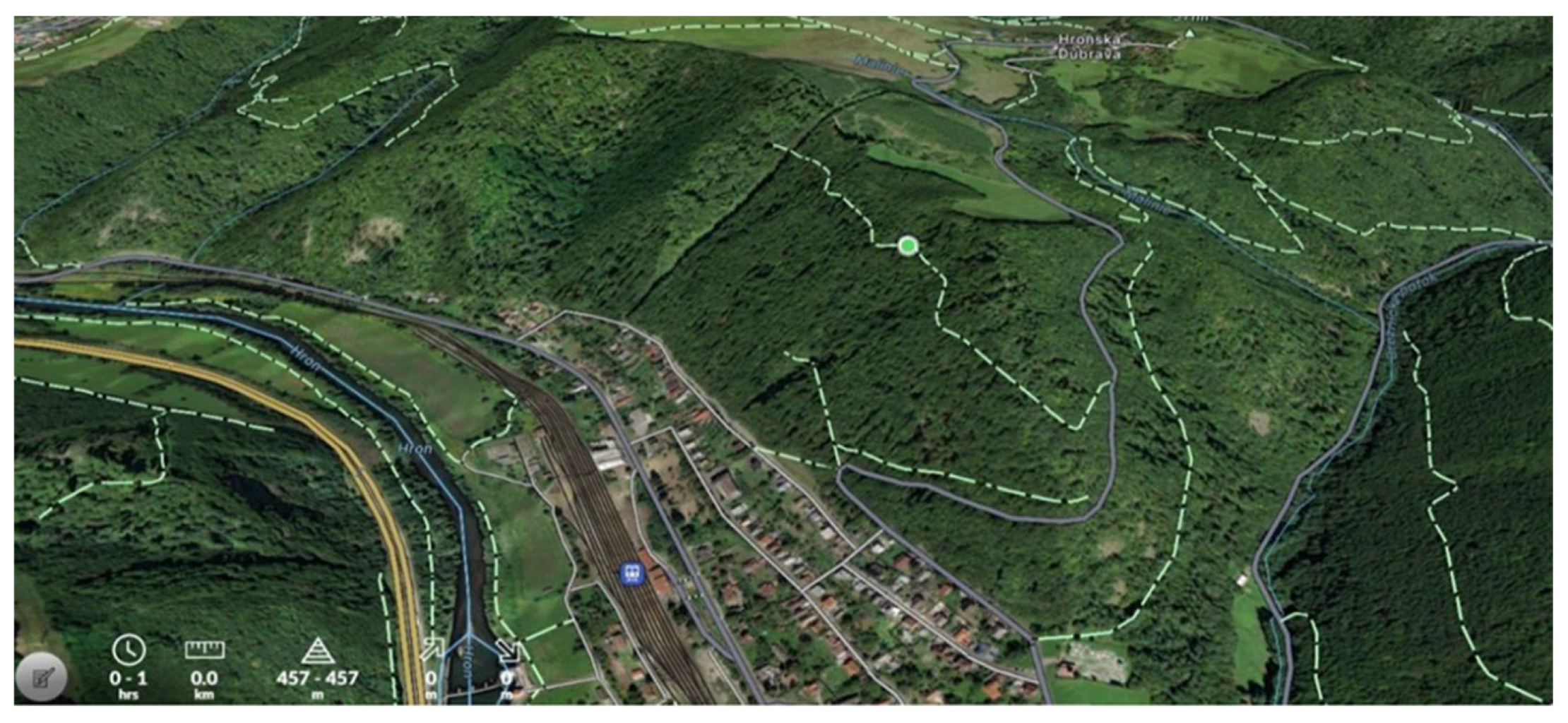

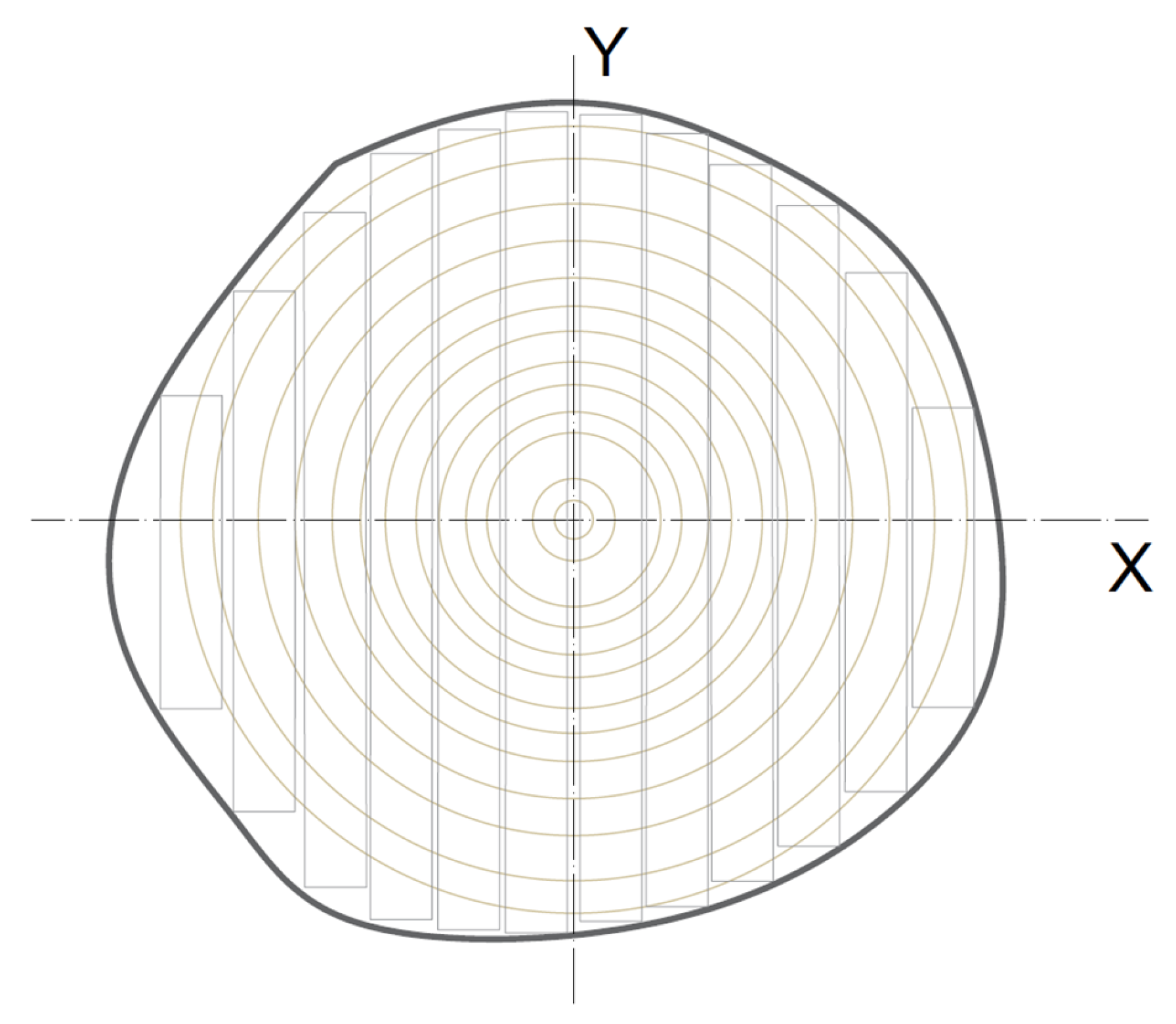

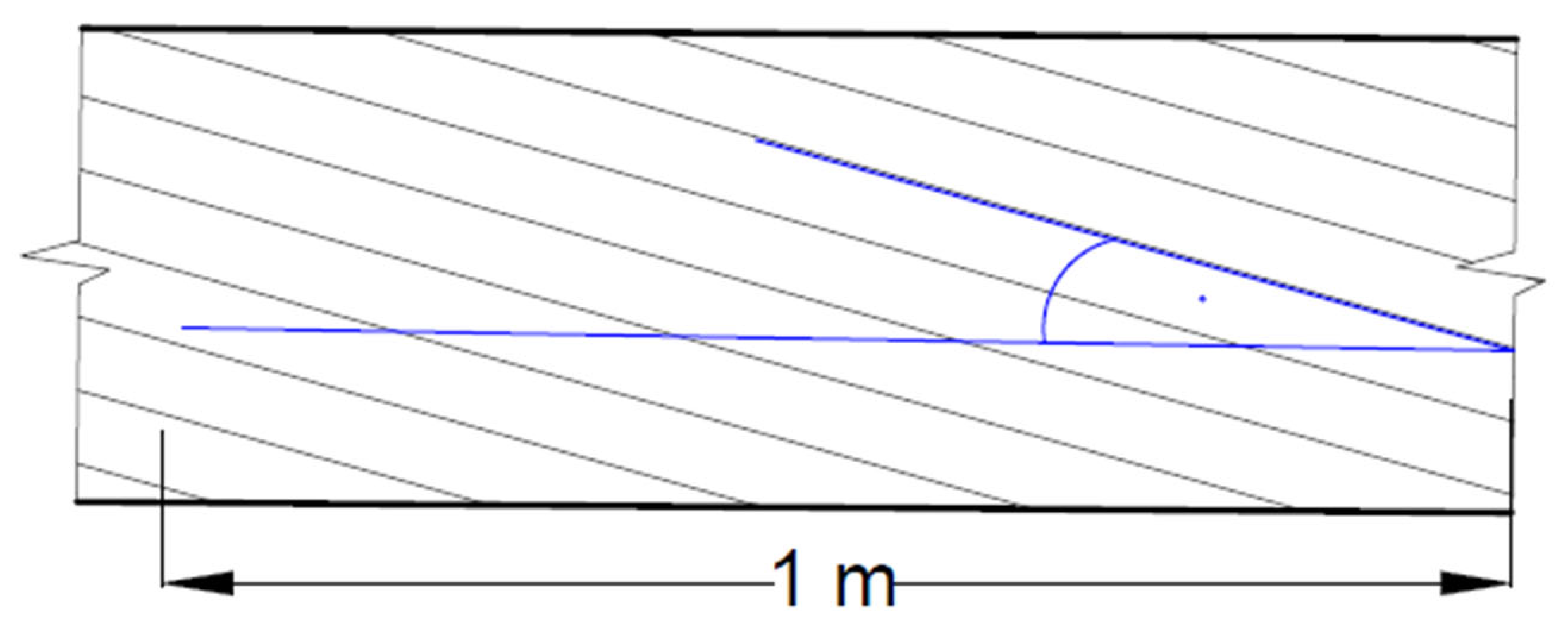
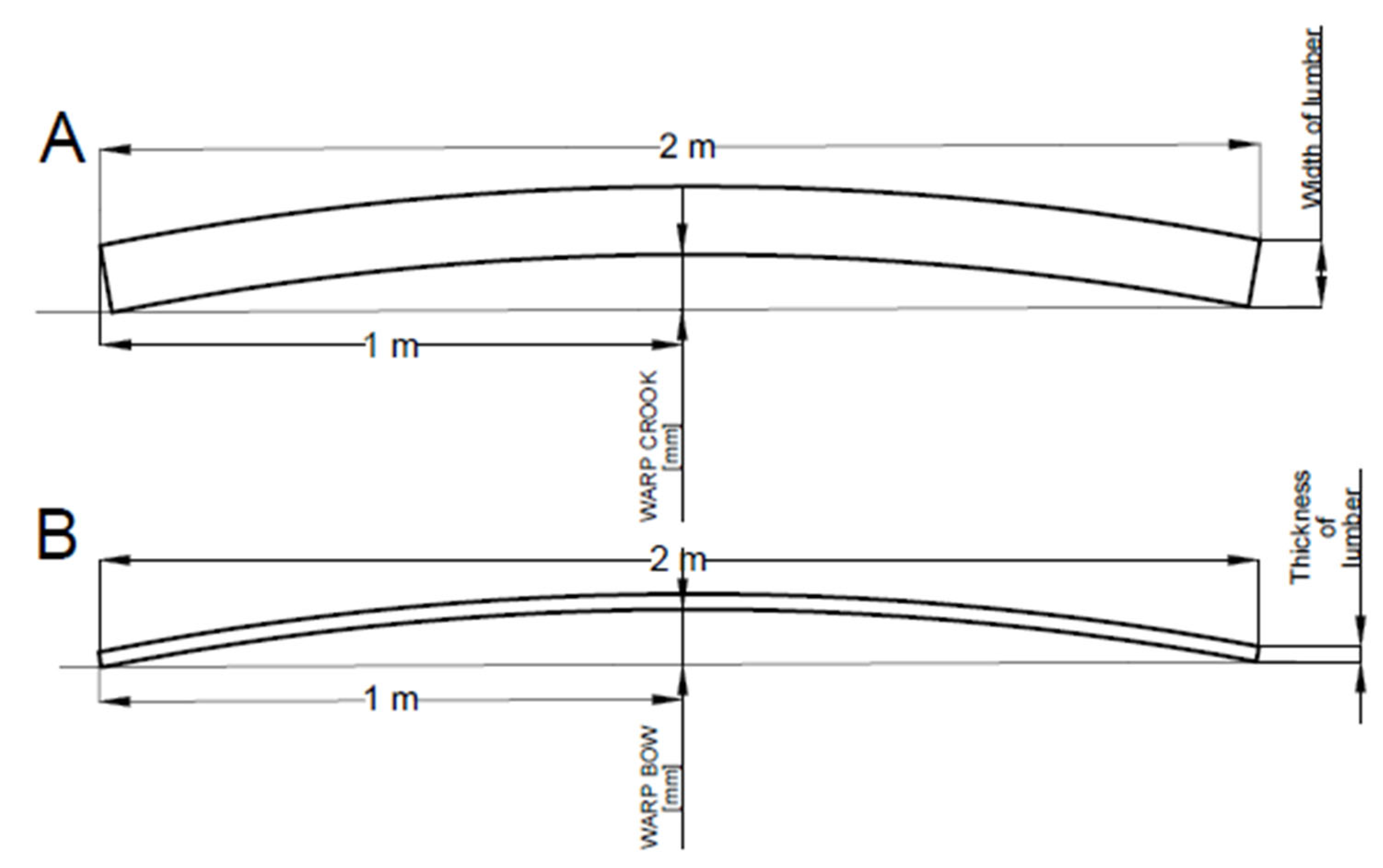

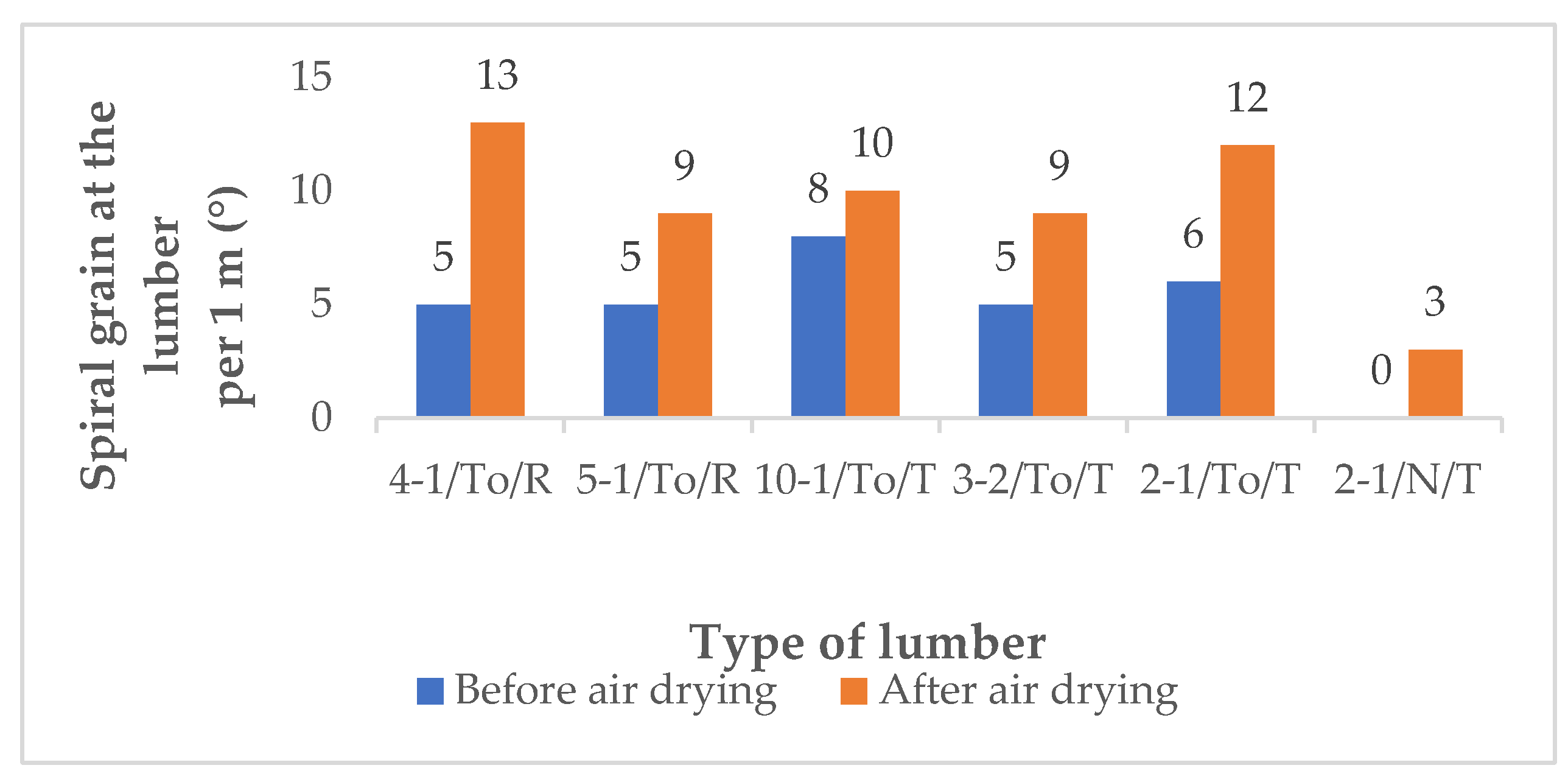




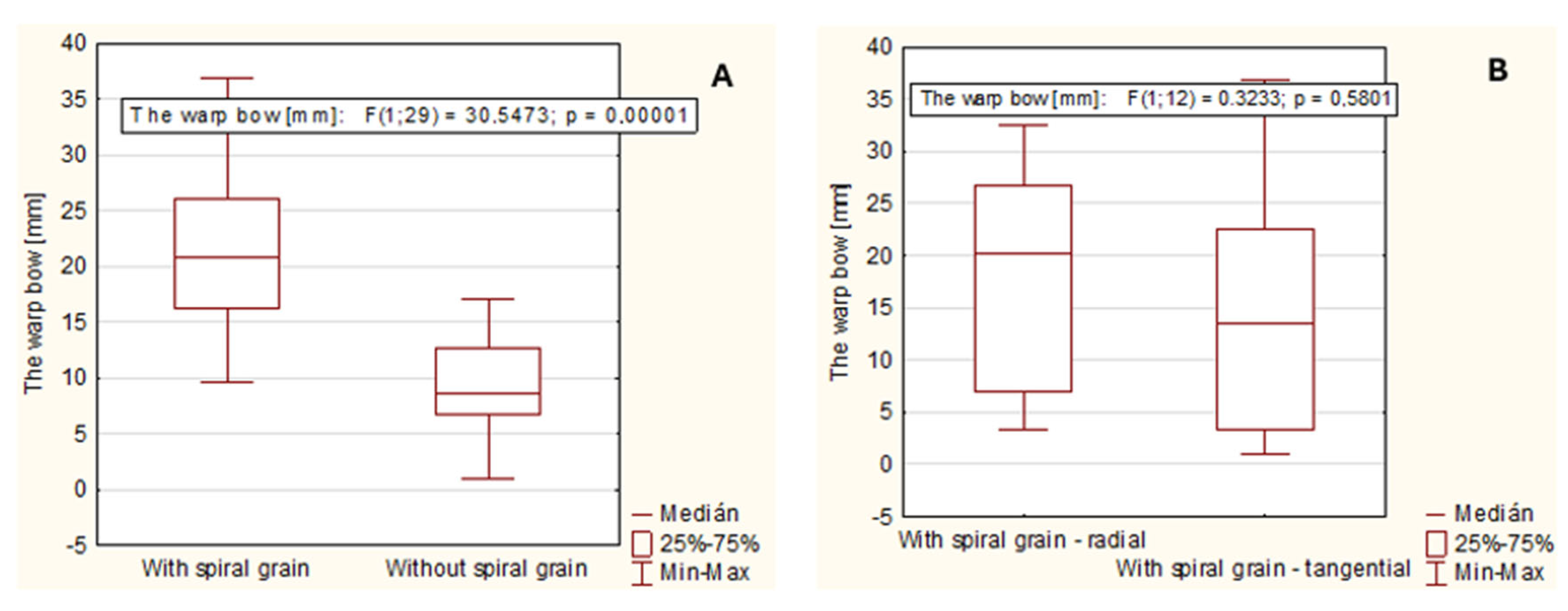
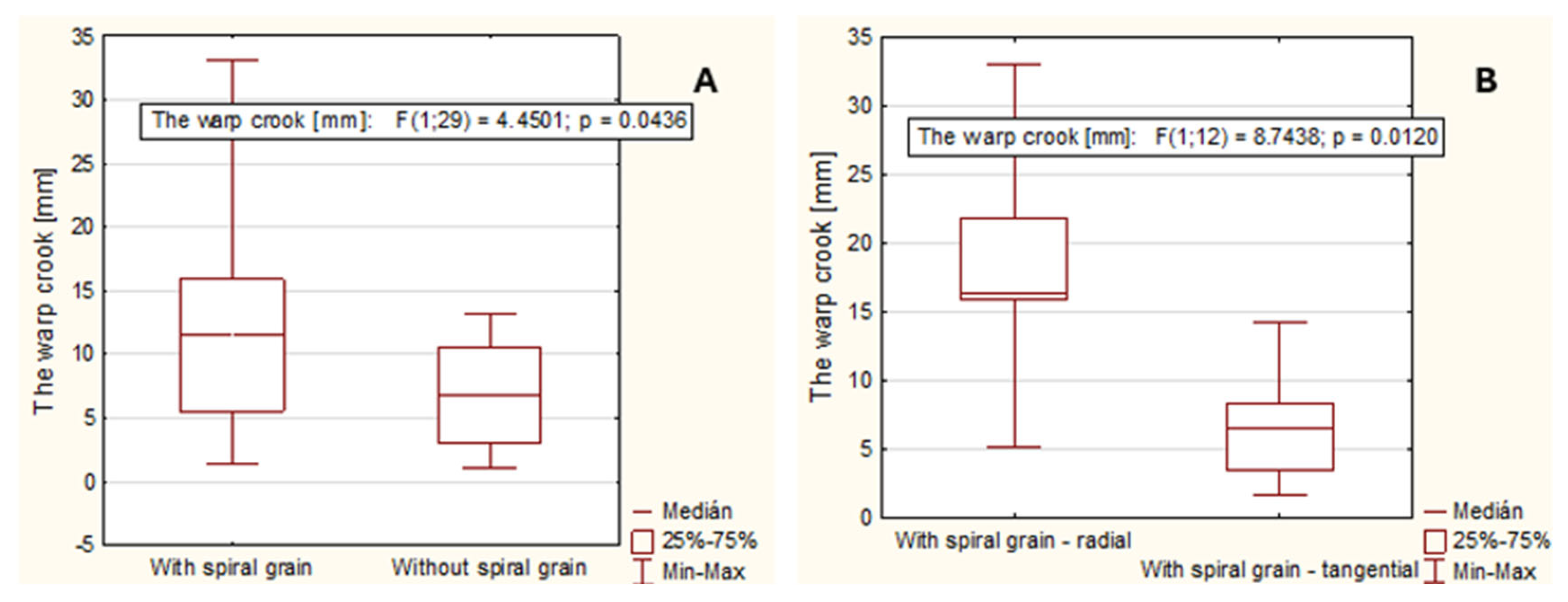
| Spiral Grain in Degrees (°) | Strength Reduction in Bending (Experimental) | Strength Reduction in Bending (Numerical Simulation) | |
|---|---|---|---|
| (%) | |||
| 4-1/To/R | 13 | 60 | 50 |
| 2-1/To/T | 12 | 60 | 50 |
| 10-1/To/T | 10 | 60 | 50 |
| 5-1/To/R | 9 | 60 | 50 |
| 3-2/To/T | 9 | 60 | 50 |
| 2-1/N/T | 3 | 0 | 10 |
| Classification of Lumber with Spiral Grain According to the Standard (DIN 4074-5) | |||||
|---|---|---|---|---|---|
| Sample | Bow (mm)-O | LS 7 | LS 10 | LS 13 | Reclaimed Wood |
| 3-2/To/T | 21.49 | O | |||
| 5-1/To/R | 18.93 | O | |||
| 2-1/To/T | 23.23 | O | |||
| 4-1/To/R | 21.94 | O | |||
| 10-1/To/T | 17.35 | O | |||
| 7-1/To/R | 36.92 | O | |||
| 6-1/To/R | 9.68 | O | |||
| 6-2/To/T | 32.59 | O | |||
| 8-2/To/T | 26.63 | O | |||
| 3-1/To/T | 13.65 | O | |||
| 9-1/To/T | 16.26 | O | |||
| 7-2/To/T | 26.2 | O | |||
| 8-1/To/R | 20.16 | O | |||
| 5-1/To/R | 13.34 | O | |||
| Classification of Lumber with No Spiral Grain According to the Standard (DIN 4074-5) | |||||
|---|---|---|---|---|---|
| Sample | Bow (mm)-O | LS 7 | LS 10 | LS 13 | Reclaimed Wood |
| 1-1/N/R | 12.74 | O | |||
| 8-2/N/T | 13.14 | O | |||
| 8-1/N/R | 10.55 | O | |||
| 10-2/N/T | 10.51 | O | |||
| 7-1/N/R | 11,92 | O | |||
| 3-3/N/R-T | 6.71 | O | |||
| 2-2/N/T | 7.89 | O | |||
| 11-1/N/T | 16.63 | O | |||
| 3-2/N/R | 8.68 | O | |||
| 10-1/N/T | 12.98 | O | |||
| 5-2/N/T | 17.11 | O | |||
| 6-1/N/R | 6.86 | O | |||
| 2-1/N/T | 4.97 | O | |||
| 6-3/N/R | 6.89 | O | |||
| 9-2/N/T | 1.81 | O | |||
| 8-3/N/T | 3.32 | O | |||
| 9-1/N/T | 1 | O | |||
Disclaimer/Publisher’s Note: The statements, opinions and data contained in all publications are solely those of the individual author(s) and contributor(s) and not of MDPI and/or the editor(s). MDPI and/or the editor(s) disclaim responsibility for any injury to people or property resulting from any ideas, methods, instructions or products referred to in the content. |
© 2024 by the authors. Licensee MDPI, Basel, Switzerland. This article is an open access article distributed under the terms and conditions of the Creative Commons Attribution (CC BY) license (https://creativecommons.org/licenses/by/4.0/).
Share and Cite
Vilkovský, P.; Uličný, H.M.; Klement, I.; Vilkovská, T. The Differences in Shape Stability for Hornbeam (Carpinus betulus L.) Lumber with and without Spiral Grain. Appl. Sci. 2024, 14, 5250. https://doi.org/10.3390/app14125250
Vilkovský P, Uličný HM, Klement I, Vilkovská T. The Differences in Shape Stability for Hornbeam (Carpinus betulus L.) Lumber with and without Spiral Grain. Applied Sciences. 2024; 14(12):5250. https://doi.org/10.3390/app14125250
Chicago/Turabian StyleVilkovský, Peter, Hugo Miroslav Uličný, Ivan Klement, and Tatiana Vilkovská. 2024. "The Differences in Shape Stability for Hornbeam (Carpinus betulus L.) Lumber with and without Spiral Grain" Applied Sciences 14, no. 12: 5250. https://doi.org/10.3390/app14125250
APA StyleVilkovský, P., Uličný, H. M., Klement, I., & Vilkovská, T. (2024). The Differences in Shape Stability for Hornbeam (Carpinus betulus L.) Lumber with and without Spiral Grain. Applied Sciences, 14(12), 5250. https://doi.org/10.3390/app14125250






